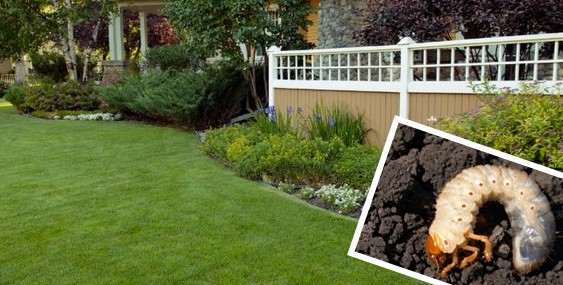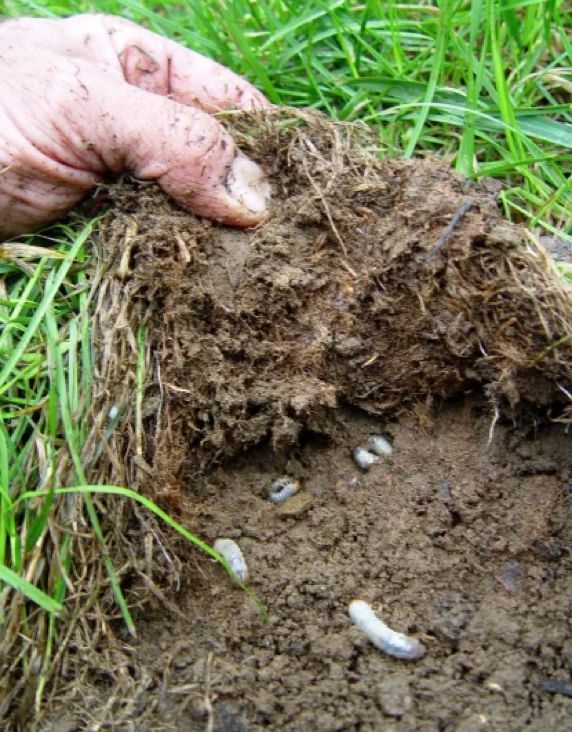This website uses cookies so that we can provide you with the best user experience possible. Cookie information is stored in your browser and performs functions such as recognising you when you return to our website and helping our team to understand which sections of the website you find most interesting and useful.
How to Maintain Grub Control and Prevent Lawn Damage
Average Customer Rating : 4.7 out of 5.0

White Grubs in Lawns: Identification, Damage, and Control
White grubs are among the most destructive lawn pests across the United States. They live in the soil and feed on turfgrass roots, weakening grass stands and causing large patches of dead turf. Understanding how to identify, prevent, and treat grubs is critical to protecting your lawn.
What Are White Grubs?
“Grubs” are the larval stage of several scarab beetles, including Japanese beetles, June beetles, and masked chafers. The beetles lay eggs in midsummer, usually in well-watered lawns. Within a few weeks, the eggs hatch into C-shaped white larvae that begin feeding on turfgrass roots.
Grubs spend most of their lives below the surface:
- Summer to fall – Feed aggressively on turf roots.
- Winter – Move deeper into the soil to survive cold conditions.
- Spring – Resume feeding before pupating into adult beetles.
Signs of Grub Damage
Not all grubs cause noticeable damage, but high populations can lead to:
- Irregular brown patches that don’t green up with watering.
- Wilting or thinning grass that pulls up easily, often with little or no root mass attached.
- Spongy or soft turf underfoot.
- Animal digging from skunks, raccoons, or moles feeding on grubs.
The only way to confirm grubs is to dig. Cut or peel back a small square of turfgrass (about 1 ft²) in areas of suspected damage. If you find more than 6–10 grubs per square foot, treatment is warranted.

Controlling Grubs
Effective control depends on timing and the right products:
Preventive control:
- Best applied in late spring to early summer to target newly hatched larvae.
- Products with imidacloprid or chlorantraniliprole prevent newly hatched grubs from establishing.
Curative control:
- Used when damaging populations are already present in late summer or fall.
- Products with clothianidin or trichlorfon are effective but provide short-term suppression only.
Cultural practices:
- Maintain a dense, healthy lawn through proper mowing, watering, and fertilization.
- Avoid overwatering, which attracts egg-laying beetles.
- Repair damaged areas with powerseeding or overseeding once grubs are controlled.
Preventing Grub Problems
Grub control is best thought of as an insurance policy for your lawn. You may not see grubs every year, but when they strike, the damage can be fast and severe. Preventive treatments that are applied protect the lawn before eggs hatch, ensuring that roots remain healthy and damage never gets a chance to start.
Preventive products are especially important if:
- Your lawn has had grub damage in the past.
- You want to avoid costly repairs from reseeding or sodding.
- You’d rather invest in protection up front than gamble on potential losses.
Healthy turf can sometimes tolerate low grub numbers, but once populations rise, even the best-kept lawns can be destroyed quickly. A preventive program provides peace of mind and keeps your lawn safe from this hidden threat.
FAQs
Will my lawn recover from grub damage? Yes, with proper care. Once grubs are controlled, powerseeding and fertilization help grass regrow. Severe infestations may require powerseeding or renovation.
Do I always need curative grub control? No. If grub counts are below threshold levels, treatment may not be necessary. Monitoring before treating saves money and avoids unnecessary pesticide use.
What about animals digging in my lawn? Skunks, raccoons, and moles dig for grubs and can cause more visible turf disruption than the grubs themselves. Managing the grub population reduces this secondary damage.
